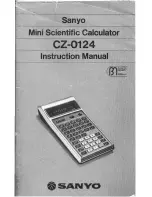
freqTable
►
list()
Catalog >
freqIntegerList
must have the same
dimension as
List1
and must contain non-
negative integer elements only. Each
element specifies the number of times the
corresponding
List1
element will be
repeated in the result list. A value of zero
excludes the corresponding
List1
element.
Note:
You can insert this function from the
computer keyboard by typing
freqTable@>list(
...
)
.
Empty (void) elements are ignored. For
more information on empty elements, see
page 232.
frequency()
Catalog >
frequency(
List1,binsList
)
⇒
list
Returns a list containing counts of the
elements in
List1
. The counts are based on
ranges (bins) that you define in
binsList
.
If
binsList
is {b(1), b(2), …, b(n)}, the
specified ranges are {
?
≤
b(1), b(1)<
?
≤
b
(2),…,b(n-1)<
?
≤
b(n), b(n)>
?
}. The resulting
list is one element longer than
binsList
.
Each element of the result corresponds to
the number of elements from
List1
that
are in the range of that bin. Expressed in
terms of the
countIf()
function, the result is
{ countIf(list,
?
≤
b(1)), countIf(list, b(1)<
?
≤
b
(2)), …, countIf(list, b(n-1)<
?
≤
b(n)), countIf
(list, b(n)>
?
)}.
Elements of
List1
that cannot be “placed in
a bin” are ignored. Empty (void) elements
are also ignored. For more information on
empty elements, see page 232.
Within the Lists & Spreadsheet application,
you can use a range of cells in place of both
arguments.
Note:
See also
countIf()
, page 39.
Explanation of result:
2
elements from
Datalist
are
≤
2.5
4
elements from
Datalist
are >2.5 and
≤
4.5
3
elements from
Datalist
are >4.5
The element “hello” is a string and cannot be
placed in any of the defined bins.
Alphabetical Listing
77
Summary of Contents for TI-Nspire CAS
Page 4: ...4 Service and Warranty Information 249 Index 251 ...
Page 248: ...248 ...
Page 250: ...250 ...
















































